Henderson’s Relish is a Sheffield institution. A spicy table sauce made to a secret family recipe that adds spice and savour to any dish.
The brand wanted more people to discover their fantastic taste and try Henderson’s instead of perhaps another ‘well-known’ table sauce.
To do this, we set out to de-risk the purchase with on pack ‘Love It, or your money back’ activation. This presents shoppers with an additional, motivating reason to consider trying Henderson’s Relish by removing barriers to purchase. If they don’t love the product then they have the option to claim their money back by visiting loveithendersonsrelish.com and uploading their receipt as proof of purchase.
The attention-grabbing collar design is bright and vibrant with simple but impactful messaging of ‘Love it or your money back’’ to catch the eye of the shoppers.
The ‘Love it or your money back’ promotion is across their Original Henderson’s Relish product and is live in stores until 31st March 2024 so keep your eyes peeled and give this spicy table sauce a chance!
Your brand – you’ve spent years getting it to the exact place you want it to be in and now it’s there, in that perfect position in your market. Your audience can now make an informed, rational decision on your brand. Everything’s perfect.
Except, it isn’t perfect. And your audience won’t make a rational decision.
Let’s take a step back for a minute. It has become increasingly accepted that your brand is no longer simply your logo, or visual identity, but is more about the experience or environment linked to your business, product or service. Your brand can no longer be considered a vehicle through which to facilitate a desired transaction, from business to consumer. It shouldn’t even be considered the sole property of the business it is associated with.
Your brand is shaped by the relationships formed in that space in-between business and people, and importantly between people themselves. It is in this acknowledgement of brand being about relationships that we must appreciate two key points:
no relationship remains the same – relationships always evolve
no-one wants to be in a relationship with someone perfect
In order to have healthy relationships you need to appreciate that people will not seek to understand your brand intellectually. Decisions are very often not made intellectually but intuitively. What is important isn’t what people know about a brand, but what they feel about a brand.
Evolution
Consider a personal relationship that may well be close to your heart – you and your mum. In one way your relationship with your mum will always remain the same, she is your mum and you are her child. That will never change. However, is that really your relationship, or is that simply a label?
Let’s consider the actual relationship you have with your mum over a lifetime. If we think about the relationship rather than the label we can see how our roles and expectations are constantly evolving. At birth we are totally dependent on our mum, without her we would die. As we grow into childhood we are nurtured by mum, but we are becoming less dependent. As older children / young adults we challenge mum, pushing for independence. Entering adulthood we become friends and equals with mum, still getting support and guidance but being able to share some of our own guidance. As mum ages we find that the dependency role switches, with mum becoming reliant on us and relying on our support. Throughout our life we remain mum and child, but the relationship is constantly evolving.
When considering your brand be aware that your relationship with people will evolve. Be open to changing roles and expectations.
Perfection
So what about perfection? Well, how would you like to be in a relationship with someone who is perfect? Someone who never does anything wrong, is always right, always the best, infallible. Sounds pretty awful right? Of course it does because we know that no-one is perfect, we all make mistakes and bad decisions. That’s not a bad thing though, it is what makes us likeable. It’s what builds relationships as everyone is fallible, we are all prone to mistakes. ‘To err is human’.
So if you are hoping to build a relationship with people through brand then forget about trying to seem perfect. We are all fallible and prone to mistakes, but what that gives is the opportunity to show growth, improvement, self-awareness. Perfection leaves no room for improvement – it is a dead state. Forget perfection.
The Space In-Between
When considering your brand, consider it the ‘space in-between’. Your brand is the space in-between numerous contributing factors, such as your business, staff, product, visual identity, customers, detractors, the current environment.
This ‘space in-between’ must be a space of vitality, of evolution, of imperfection, if you want people to relate to the brand and the brand to remain relevant. This ‘space in-between’ is not static or stagnant, it is always in-process. It should be considered temporally rather than spacially. It will most often be appreciated and experienced intuitively not intellectually. When considering your brand – the ‘space in-between’ – it’s not rational, it’s emotional.
Contributed by Paul Bailey Strategy Director Halo
For over 20 years, I’ve been working in or running my own branding agency. First design side, and then moving strategy side, I’ve learned a thing or two in my time. However, there is one thing which I seem to learn but then need to relearn again and again, and that is the need for and the role of transparency.
Now, what has led me to relearning the need for transparency you might ask? Well, in my current role I am Brand Strategy Director. This means I’m not only responsible for the brand strategy work with clients, nor does it mean I’m only responsible for the rest of our strategy team. No, what I take this role to mean is that I am responsible for the understanding and application of brand strategy from the whole of the agency.
As a full-service agency, we have people doing all sorts of roles, from design, to development, to client partnerships. Everyone will, at some point, work with the strategy team on projects, and so I believe that the more they can understand strategy the better and more effective our agency’s work will be. Now, of course, in meetings people get a little window into what we do in strategy, but I realized that in order to really make the strategy teams work transparent I needed to find ways to open up our working. So, I decided that I would decorate the walls with some of the models and frameworks that we might use in a project. (See above)
Models and frameworks seem to be either loved or loathed by strategists, but the use of a good one can create much needed focus at a critical point in a project.
The thing about them is, they’re not intended to give you an answer. In fact, even the best use of the smartest model only ever gives you an approximation of the answer. But for me, that is fine, because in strategy there is never really an answer, there’s just one of a number of answers.
So, I looked through the models I’ve used over the years, printed out some of the best and most used ones, and stuck them on the wall. This immediately led to some great feedback and some very interested people passing our strategy area. Conversations about models, their uses and application, and what they would be useful for, flowed freely. You see, once you put your ways of working out there, people are invested and interested.
In a project, models should be used as your hidden secret. We use them to create focus from a wide range of inputs, but we rarely show them to clients. They’re not really the best way to present work, so we use them as a tool for focusing our work, not presenting it. Good models should be used to cut, to hone, to give you less and not more.
Now there are many models I no longer use, they no longer meet my standards and have been dropped. As I said previously, I’ve spent over 20 years doing this, and one of the things I have learned is what models work, and which ones don’t. So, here’s a short list of a few of the models I still use, and what I use them for.
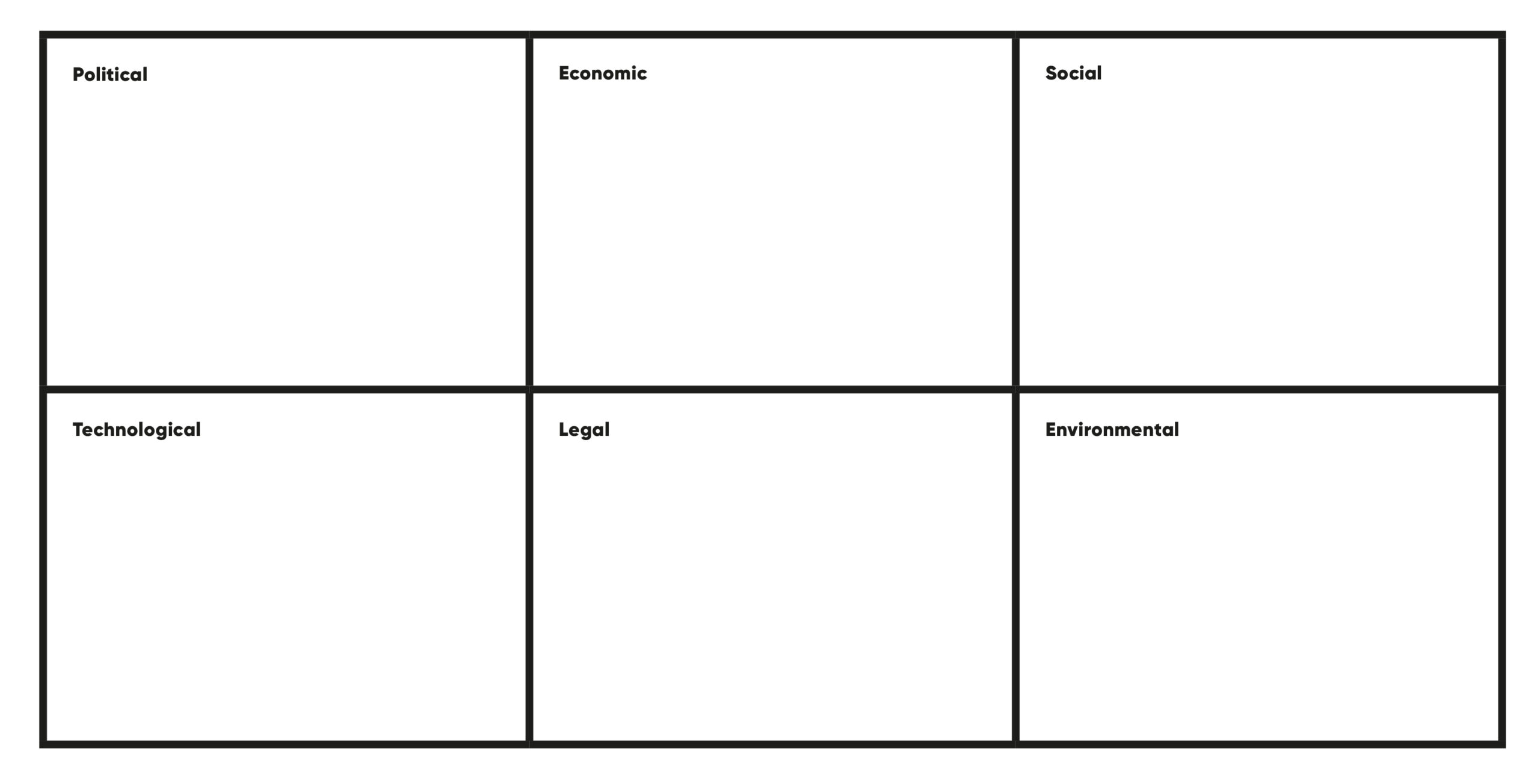
1. PESTLE
This model is old, and many people knock it, but I still use it. Why I use it is I find it a simple and helpful structure to work through one of the aspects of the context within which our brand exists – market forces. The six areas the PESTLE name stands for (Political, Economic, Social, Technological, Legal, Environmental) are still a good way to break down the market forces at play on a business and its associated brand. I find that they help me focus, but also they give an indication as to the areas in which a business has more to think about.
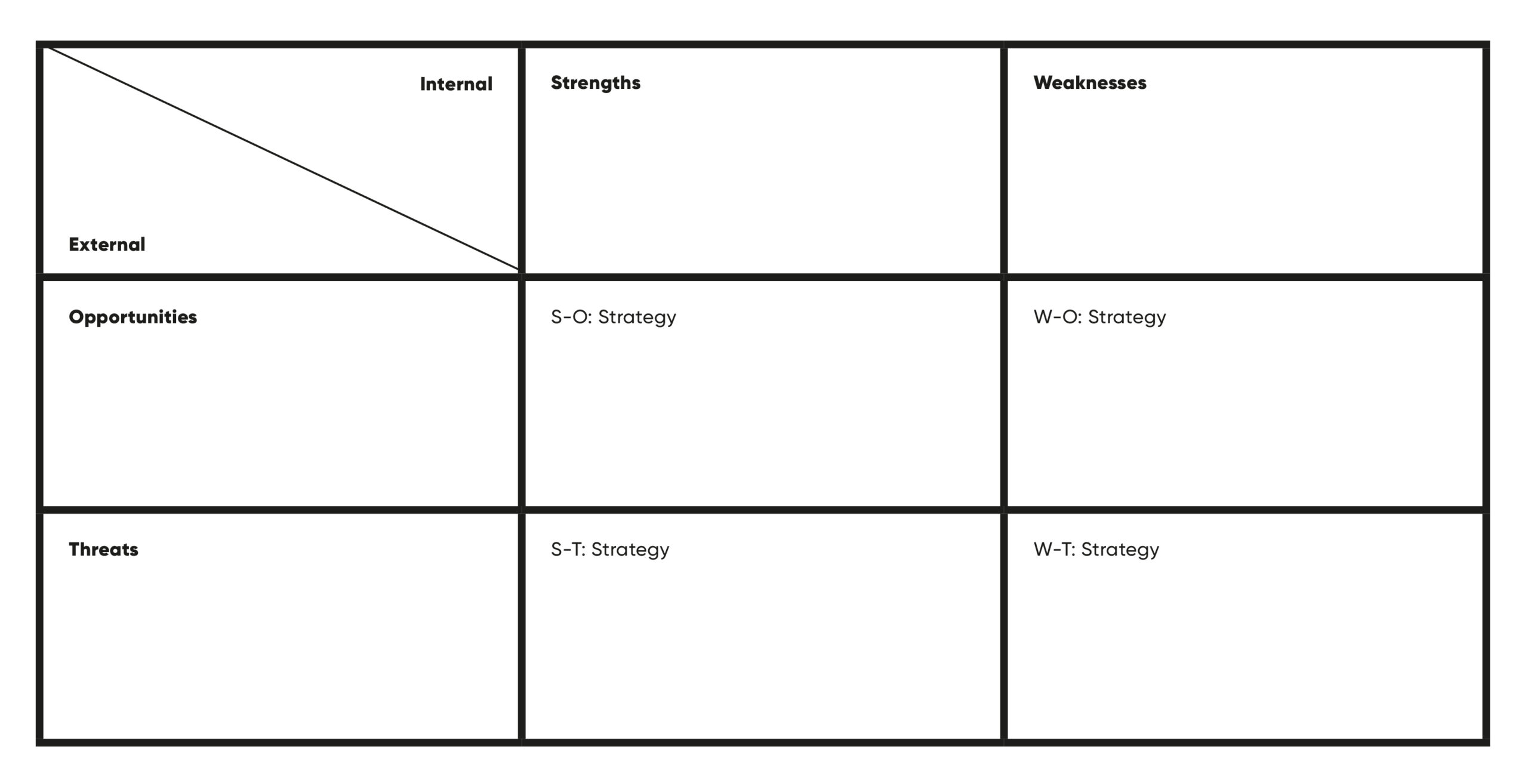
2. SWOT
Yet again, another old model that doesn’t get much love these days. Well, I still love it. When we are researching a brand project there are two key areas we need to find out about – the context (market forces, audience, competition) but also the business itself. The SWOT gives us a very simple model to learn something of what the business is good and bad at, and where they see opportunities and threats. Now, the slight variation in my model is that I use a grid which sets out the strengths and weaknesses, and the opportunities and threats on the outer edges, but on the inside where they cross over there are four panels where you can start to set out strategies for improvement (S-O, S-T, W-O, W-T).
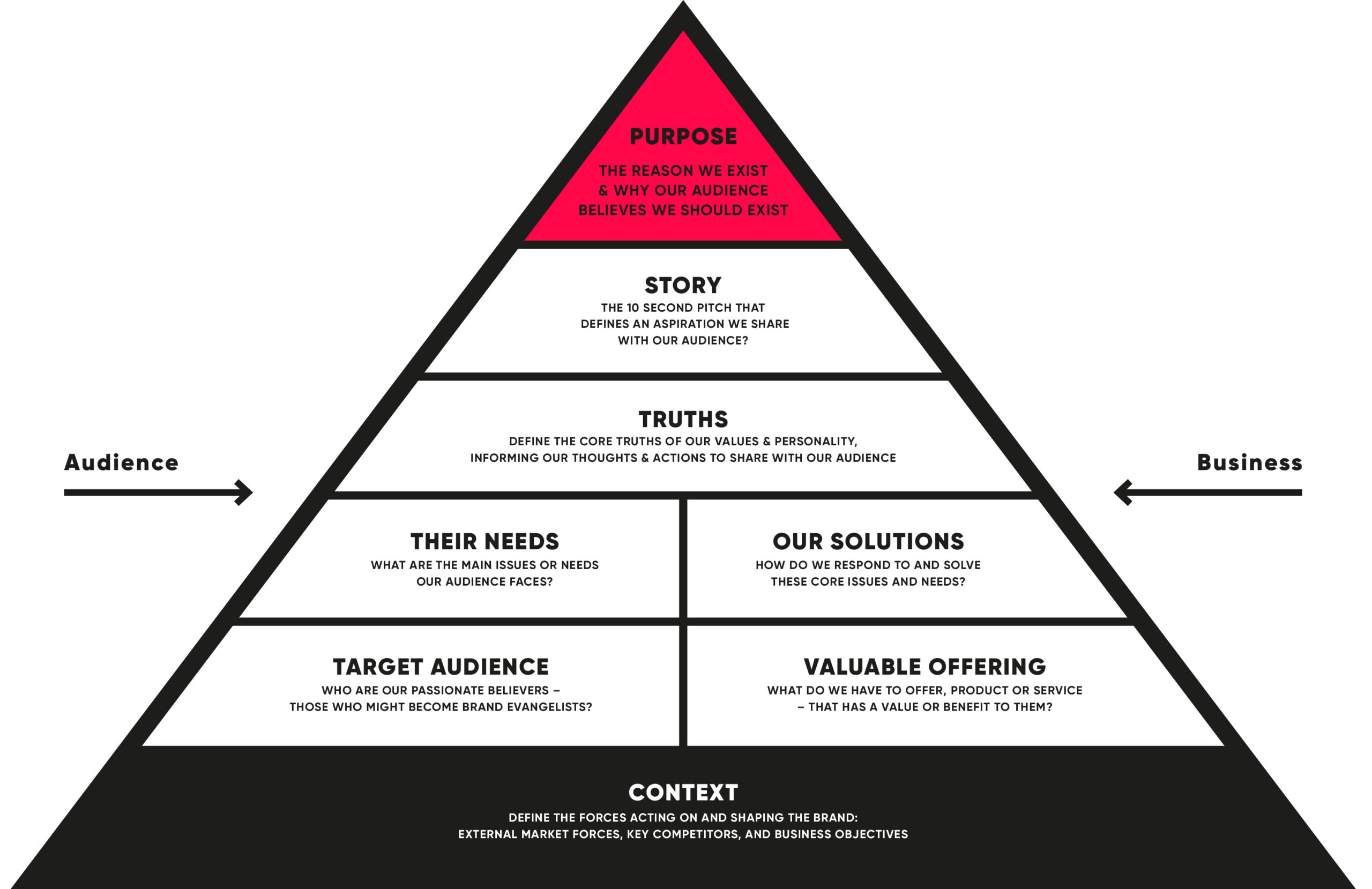
3. Brand Pyramid
Now I don’t think I’ve ever shown this as a pyramid to a client. The reason I find the pyramid useful is that it mirrors the process I go through mentally to try and reach a core brand proposition. At the base of the pyramid is the context within which the brand exists (market forces, audience, competitors). The wider this base is (the more research we can do at this stage) then the more stable the pyramid will be. Diagnosis of the context of a brand is the foundation of a good brand proposition. At the other end of the pyramid is the point, the tip, the core proposition that encapsulates the core value of the brand to its audience. You might manage to get this down to only a few words, or at most a sentence or two, because this should be the distillation of all of your work so far.
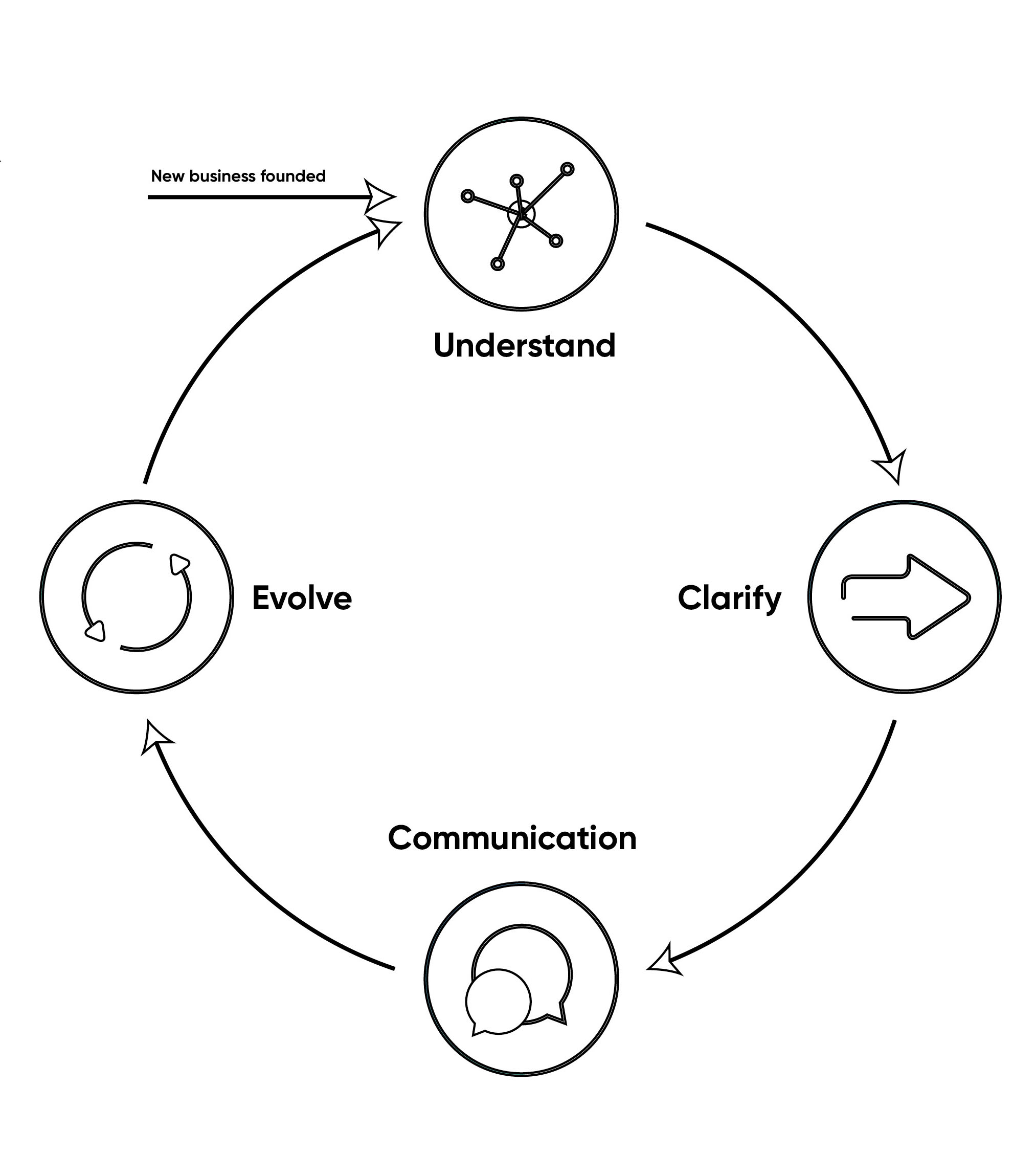
4. Evolutionary Brand Cycle
There are many models like this, but this is the one I use. It is a simple breakdown of a never ending process of evolution which every brand should constantly go through. Because, although we’ve just written a distillation of the brand, in reality the brand is always changing and shifting to a point. A brand is a dynamic entity which evolves over time. So, this model has four stages; Understanding, Clarifying, Communication, and Evolution. Understanding is your research phase. Clarifying is your distillation phase. Communication is your communicating phase. And Evolution is your listening phase. Keep doing these phases, over time, and your brand can shift and move at the right place and the right times.
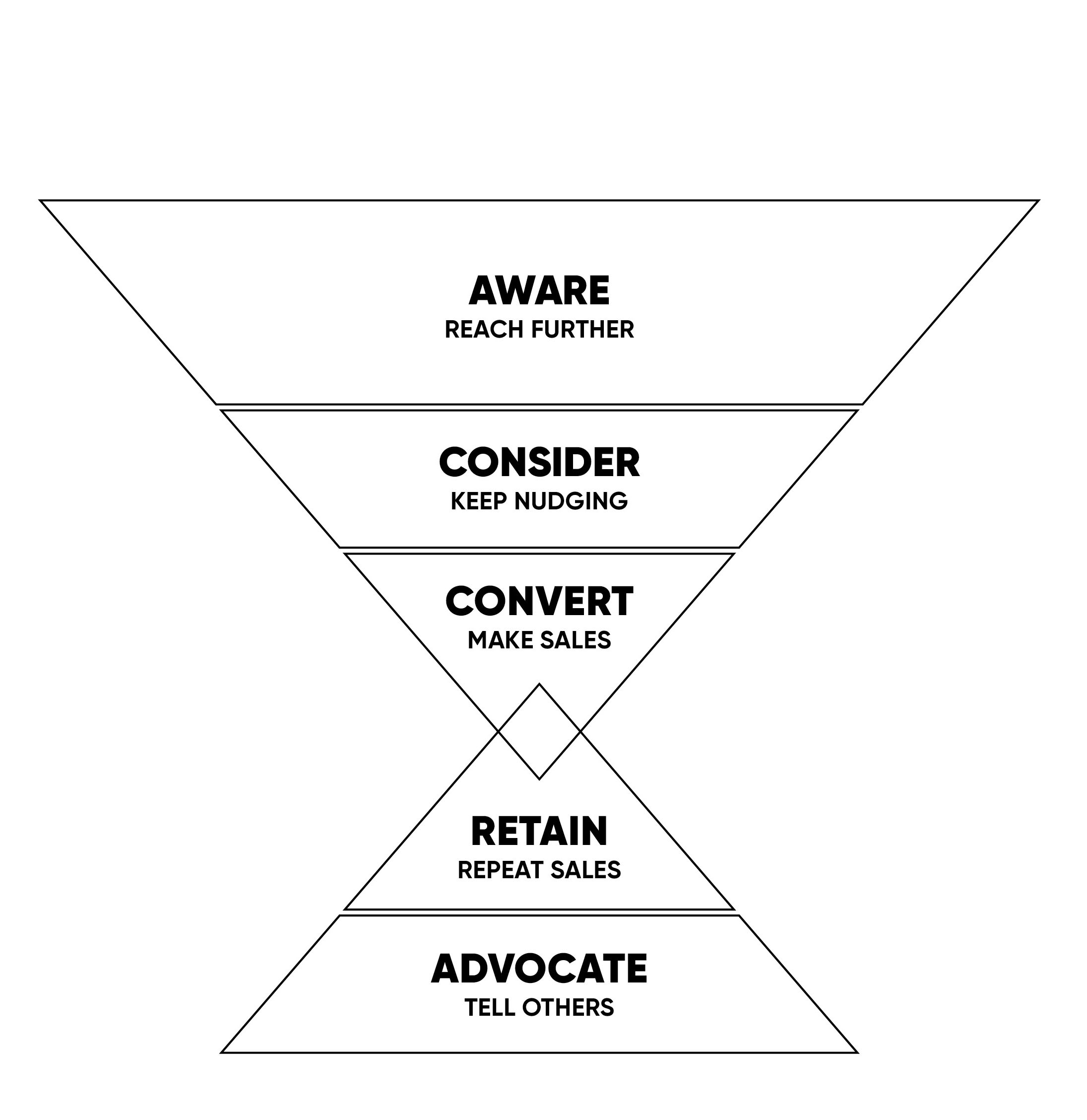
5. Marketing Sales Funnel
The Marketing sales funnel is yet another old and supposedly broken model. Not as far as I am concerned it isn’t. Now, my approach to the marketing sales funnel is quite loose, and we don’t put strict rules on how we use it. What we do find it useful for is assessing what marketing touchpoint should be used for which part of the journey through the funnel. At the top of the funnel we are looking at Awareness, and so touchpoints such as OOH and TVC will feature heavily. At the bottom of our funnel we have Advocacy, so Google Reviews or user reviews may feature here. Really, we find the funnel a helpful tool to give our touchpoints a role and responsibility.
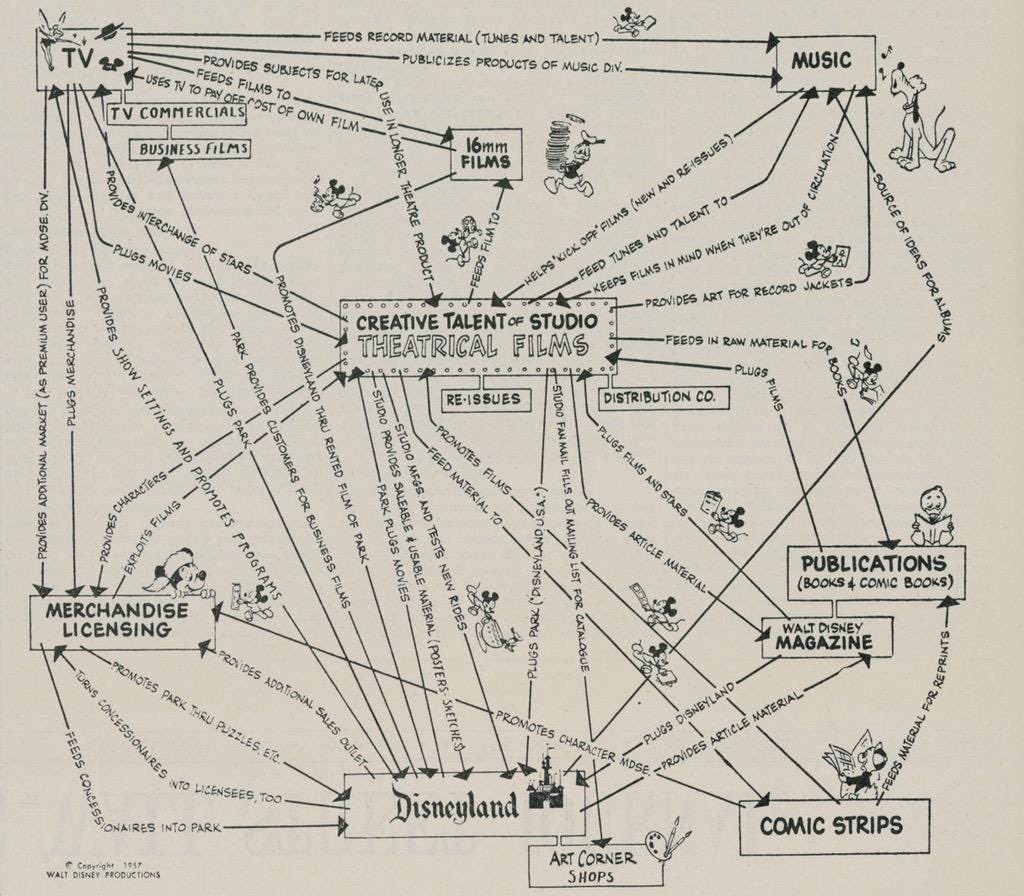
6. Experience Ecosystem
Finally, we move into the Experience ecosystem. What is this you might ask? Well, it is something that we do to give a function to every ‘moment’ a person comes into contact with our brand. A ‘moment’ is an audience-centered view of a touchpoint. Brands are shaped through ‘Associated Memorable Moments’, and every one of these moments in time should be used to encourage a desired action or reaction. Whether that action or reaction is just awareness of your brand, or is a driver to purchase, if you attribute a behavior you would like to encourage from that ‘moment’ you are creating a focus for everything you do. Make sure every moment is clearly identifiable as you, and is remembered for something you would like.
BJ Fogg’s Behavior Model is also useful here – motivation + ability + prompt = behavior.
So, there are six models I use pretty often. Of course, there are many more worth using. From Kapferer’s Brand Identity Prism to Keller’s Brand pyramid, Stephen King’s Planning Cycle to Kotler & Armstrong’s 3 Product Levels. But remember, a model is only there to help you cut and refine. It will never give you the answer, and what you get out is only ever as good as the quality of research you put into it. As I said at the beginning, there is a value in and a need for structure.
Contributed by: Paul Bailey, Strategy Director at Halo
Bristol-based direct marketing agency Flourish has been recognised for its email marketing achievements at this year’s national Performance Marketing World Awards.
The awards were held at The Grosvenor Hotel on Park Lane in London and Flourish scooped the Email Marketing award for their work with well-known consumer electronics brand, Samsung. They were one of 22 winners out of more than 90 shortlisted finalists, alongside other award-winning entries including the likes of Asda, Specsavers, Boots, Primark and M&S.
Robin Langford from PMW wrote: “The victors reflect outstanding work across a number of product sectors, alongside awards for the best people, agencies, innovations and teams.”
Flourish also has an office in Dubai and a long-standing relationship with the Samsung Gulf team. They were asked to work on the launch of the Galaxy S22 Series across several regions and in multiple languages. The team assisted with the planning and implementation of a communications strategy that helped Samsung to achieve a high number of pre-orders, and exceeded results from their previous launches of similar devices.
Ian Reeves, Managing Director at Flourish, said: “2022 has been a fantastic year for Flourish, and we are extremely proud to top it off by winning an award that celebrates the game-changing results possible when data, technology and people come together to create customer orientated journeys. This award is credit to the whole team at Flourish and their dedication to pushing boundaries in CRM.”
The campaign has also received recognition by industry body reallygoodemails.com and an internal Samsung marketing award for the campaign with the best use of segmentation.
You can find out more about Flourish via the website.
Sarah Warewinter joins Bristol operation as Associate Director, Strategy
McCann has bolstered its strategy team in Bristol with the appointment of Sarah Warewinter. Sarah joins as Associate Director for Strategy having headed up IMA HOME’s insight and strategy team in Leeds for 11 years.
Prior to her time at IMA HOME, Sarah worked across a diverse range of sectors, with her portfolio including major brands such as Argos, Dr Oetker, Interflora, Jet2 and the NHS.
In her new role, Sarah will build on the strength of the existing team to deliver meaningful work for the agency and its clients. Talking about her appointment, managing director Andy Reid said: “Across the globe, McCann is known for providing our marketers with best-in-class strategic and creative services to help brands play a meaningful role in people’s lives.
“For us at McCann Bristol, Sarah’s appointment is central to delivering this core function, as we continue to proudly create award-winning work for our clients. Sarah comes with an impressive track record, along with a wealth of expertise across a range of sectors and I’m pleased to welcome her to our senior leadership team as we head towards 2023.”
Sarah added: “I’m really excited to join the McCann family. The ambition and direction of the business is really exciting, and I can’t wait to be involved in the next stage of growth for McCann Bristol.”
JonesMillbank, Bristol-based video production company, were commissioned by leading engineering consultancy firm Hoare Lea to celebrate the arrival of the National Satellite Test Facility (NSTF).
As unseen stewards of communication, man-made satellites keep us safe, informed and entertained, and their voyage into space demands phenomenal technical skill at every stage.
World-class science research, expertise and innovative testing transports them from concept to lift-off, and the unique design of the NSTF’s ‘cathedral-like’ facility means the chaos and challenges of space can be recreated here on earth.
Specialist equipment shakes, bakes and blasts satellites in the final phase of their ground development, testing them to their limits and arming them with the best preparation possible before their final journey into the unknowns of the cosmos.
JonesMillbank worked with Dr Jackie Bell, PhD, an aspiring astronaut and theoretical physicist who featured on BBC’s Astronauts: Do You Have What It Takes?, whose own journey through the space industry has tested her in every way imaginable.
The film was shot on location at the facility in Oxfordshire with support from RAL Space.
Visit https://jonesmillbank.com/work/hoare-lea/national-satellite-test-facility to view the film and https://hoarelea.com/2022/11/03/the-national-satellite-test-facility to find out more about the project.
***
JonesMillbank are a passionate full-service video production company
They work in-house with a talented team of multi-disciplined creatives, all the while telling authentic stories long before it was cool for a range of clients such as University of Bristol, IDLES, NHS England, The Royal Mint and Battersea.
jonesmillbank.com
01173706372
hello@jonesmillbank.com
Bopgun, a brand, strategy and digital agency, has been selected from a number of agencies to support Puzzler Media with the UX, design and development for a new lead generating B2B website.
Puzzler Media is the UK’s largest supplier of printed and digital puzzle-based content, backed up by end-to-end content management and support. With over 50 years’ experience, Puzzler Media is the go-to name in puzzles, working with business worldwide from national and regional newspapers to magazines, membership organisations and individual brands.
With only a consumer-facing website, Puzzler Media identified the need for a new B2B website to improve their online presence, increase brand awareness and ultimately generate leads. The website will showcase the huge range of puzzles on offer, alongside solutions to deliver content and client case studies that demonstrate their experience and capability – all delivered in a clean and user-friendly design.
“B2B is an exciting and growing part of our business. We help a multitude of clients in supplying print and digital puzzle content and tech solutions. We didn’t have a site that reflected the breadth of content and the quality of our client base. We chose Bopgun because, based on the good work we have seen them deliver for other clients, we believed they were the best agency to deliver our Puzzler Business Partnerships ‘shop-window’. We’re really excited to be partnering with them on this project.” Lynda Newland, Deputy MD, Puzzler Media.
Launched in 2008, Bopgun is a multi-disciplined creative agency with an unrivalled background across the publishing industry. With both the founders having worked in various roles at Future Publishing for over 14 years between them, Bopgun has grown into a substantial and distinguished company working with some of the world’s leading industry players including Elsevier, Story House Egmont, Anthem Media, Hachette Partworks and Kelsey Media to name a few.
From engaging websites for the likes of Marvel and Disney, to e-commerce subscription sites, promotional campaigns, animations and illustrations, Bopgun prides itself on delivering real value to the publishing industry.
“We were thrilled when we heard we’d won this project with such a prestigious brand as Puzzler, known by their existing clients as the UK’s largest puzzle supplier. Knowing how important it is for their business to convey their detailed and wide range of puzzles is the sort of challenge we love!” David Mathews, Managing Director at Bopgun.
Eight new recruits, including Business Development Director, Marketing Manager and Medical Writer join Create Health.
Bristol-based healthcare marketing agency Create Health is strengthening its team across the board with new appointments across departments, welcoming eight new team members in total.
Carys Richards brings a wealth of experience from the Pharma sector to the Create Health team as Business Development Director.
Meanwhile, Sean Quay joins the team as a Medical Writer. He comes from a clinical background, with time spent in pharmacy and primary care working on regional level pharmacy projects like driving medicine optimisation and public health campaigns.
Junior Graphic Designer Amelia Horner initially joined the agency as an intern, taking advantage of Create Health’s apprenticeship scheme to secure a full-time role.
In addition, the agency welcomes, Charlie Culverhouse as Senior Account Manager, Kate Wells as Junior Art Director, Jasmine Freeman as Marketing Manager, Joe Wilson as Motion Graphics Designer and Rhi Wheeler as Account Executive.
Managing Partner Ed Hudson said “The Create Health team growing at such a rate signals the exciting times ahead not just for the agency but for the healthcare communications industry. We’re thrilled to have brought on board a roster of talented individuals who will help us to push the boundaries of creativity and make a positive difference to healthcare professionals and patients alike.”
Medical Writer Sean Quay, added “Healthcare communications is booming and being part of Create Health feels like I’m aboard a rocket about to launch.”
McCann Bristol has created an emotive new brand campaign for St Austell Brewery and its flagship brand, Tribute, to reflect the pride, passion, and independence they both share with the local Cornish community.
‘The independent ale from the independent people,’ campaign pays Tribute to stand-out Cornish people who embody independence. The first phase of the new campaign features three strong and intimate photographic portraits – revealed only by the hands.
Cornish fisherman, Philip, Penzance-based local female rugby team founder, Cozette, and Cornwall-born musician, Mark all feature in the first phase of the campaign, which will be rolled out across both point of sale and advertising on billboards and digital channels, as well as featuring on the brand’s lorry livery in the coming months.
Laura McKay, head of marketing – beer and brands, St Austell Brewery, comments:
“Tribute is all about the people that make it. And for us, that’s drawing inspiration from our location and Cornish folk. In an honest and authentic way, through the new campaign photography, we’re celebrating the best of Cornish people and shining a spotlight on the hands that hold onto their passions.
“The new emotive advertising aims to create a stronger connection with Tribute’s target audience, communicating the importance we place on independence, endeavor, and achievement – characteristics reflected in both the brand and Cornwall itself. The spirit of independence is what makes Tribute unique.”
Zane Radcliffe, Executive Creative Director at McCann Bristol, said: “We’re as proud of this debut campaign for St.Austell as the Cornish are of their independence. We’ve captured that spirit in a series of striking and contemporary portraits of the hands that connect them to their individual passions and to the ale they prize so strongly.”
The campaign creative was shot by photographer Alex Telfer who boasts accolades including the International Photography Awards’ highly acclaimed ‘Photographer of the Year’.
Most wealth management firms have an ageing client base, predominantly those over 60 years old (baby boomers) and over 75s – the silent generation. To combat this, they target their acquisition activity to wealthy investors of 45 years old (generation x) and over.
The conventional thinking is that 45-55 is the age when people have already established their own wealth and are likely to start inheriting from their baby boomer parents.
Conventional thinking also dictates that millennials (26-41 year olds) are mostly too financially squeezed to meet the threshold of an attractive prospect for wealth management services.
This conventional thinking has held true for the past 100 years.
But these are unconventional times.
“…the number of UK millennial and generation Z millionaires has doubled in the past year…”
Research by the Bowmore Wealth Group in February 2022 reports that the number of UK millennial and generation Z millionaires has doubled in the past year. The research also shows a 28% increase in millennial and Gen Z taxpayers declaring income over £150,000. This is largely due to a surge in pay for workers in tech/fintech and a boom in millennial entrepreneurship. The number of younger high-earners working in areas such as sport and social media influencing is also rising.
Much has been said about the projected intergenerational wealth transfer. The narrative is that globally baby boomers will pass on between $30tn and $68tn (depending on which report you read) of their wealth to their millennial children within the next 10-20 years.
But there is growing evidence that the wealth transfer is skipping a generation. The silent generation are passing their wealth to their millennial grandchildren, and Gen Z are inheriting from their baby boomer grandparents.
And this wealth is dropping on a generation that seems to have a greater propensity to invest than their parents, according to surveys by Finder.com and the Royal Mint.
View image in blog here.
You’d think that wealth management companies are well positioned to capitalise on this opportunity. Surely they can parley their long-held relationships across to the inheriting generations? Apparently not.
“…only 13% of affluent investors choose to work with the same advisor their parents used…”
Research by Cerulli Associates reports that only 13% of affluent investors choose to work with the same advisor their parents used. Among the remaining 87%, a whopping 88% of them said they never even considered doing so. The impact of this is seemingly dramatic. Accenture reports that wealth managers expect to lose, on average, one-third (32%) of their client’s wealth at the point of succession. That’s an estimated outflow of $1.5tn per annum.
It’s little wonder that the wealth management sector is struggling with this tide of change. Industry figures show that the average age of wealth advisors is rising to around the high 50s, with only 11.7% under the age of 35.
“…the average age of wealth advisors is rising to around the high 50s…”
The received wisdom about millennial and Gen Z prospects, meanwhile, is that they’re more self-directed than older generations, and demand technology that enables them to take control over their finances. They have a wealth – pun intended– of information at their fingertips, and in many respects consider themselves more knowledgeable than their advisor (in 64% of cases, according to Accenture research).
An Accenture poll of millennials highlights the stress this generation gap places on trust, which is essential in a relationship-centric business. 57% of respondents perceived their advisor to be motivated by their own earnings alone – as opposed to the client’s financial success – and less than a third of them felt their advisor took the time to get to know them. Combined with the fact that 51% of them agreed with the statement: “I try to avoid situations where people tell me what to do,” it’s clear advisors have their work cut out for them.
So, can wealth management firms ride the storm? Or is the writing on the wall? Recent research suggests the former – and the storm may not be as overwhelming as it seems.
In 2022 Natixis surveyed 8,550 millennials globally with a minimum of $100,000 in investable assets. The results ran against prevailing perceptions, showing that robo-advice has only captured a small percentage of the market.
See image in blog here.
The research concludes that a primary reason for this lies in the fact their lives become more complex as they turn 30, and they look for personal advice, either as a sole source, or as part of a blended approach to their finances.
Technology is a core enabler of these relationships, providing ease of access and transparency of information combined with multi-channel lines of communication between client and advisor.
While, according to Accenture, most millennials are confident in their own knowledge of holdings and investments, 59% of them want education on financial basics like cashflow and budgeting, with an equal focus both on short-term and long-term goals.
Millennials will also be experiencing one of the most dramatic periods of volatility they’ve seen as investors, with 48% of respondents focused on risk management over a fund’s ability to beat the benchmarks (26%) when selecting investments.
The generalisation that millennials are champions of impact investment is also challenged. While 78% considered their wealth as an extension of their values, and 52% said they were interested in ESG (environmental, social and governance) investments, only 27% said they were currently invested in ESG funds. And though a Schroders study shows that the majority UK millennial investors are driven by their personal beliefs, 20% of them would actually compromise those beliefs if the returns were high enough.
Time to advertise outside the box?
These statistics combine to show that it’s risky to approach millennials using commonly held generalisations and assumptions about generational differences. They’re just like any other investor, just at a different life-stage. Indeed, Accenture segment their millennials-focused research panels into very recognisable attitudinal personas.
“…it’s risky to approach millennials using commonly held generalisations and assumptions about generational differences…”
Sure, millennials can be driven by values, but not all of them are. And their parents are just as likely to make ESG investments as they are.
Yes, the research shows that, when asked, millennials don’t like being told what to do. But who does? A good wealth manager works together with their clients – something that UBS reflect so well in their core proposition as we saw in our first article.
Certainly, a large proportion of inheritors sack their parent’s advisor. But that’s not because they want specialist millennial-tailored advice. It’s because they were excluded from the conversation – ignored – just as we found women were in our previous article.
Millennials are information-hungry, goal-driven and ask a lot of questions, as do women. But is that so different to the rest of the investor population? Again, goals and questions are central to the well-considered UBS narrative. It certainly doesn’t marginalise anyone. It’s an inclusive and contemporary attitude.
And as for that old trope that millennials are different because they’re digital natives – well, we’ve actually reached a point of societal digital maturity. We all expect digital service. There’s no such thing as a digital offering that’s just for millennials.
Good digital communications and experiences are effective when they work with the strengths of the medium and are driven by common heuristic behavioural principles.
The key, we believe, to attracting a millennial audience is to apply the same approach UBS has successfully applied to attracting women:
In our opinion, Schroders Personal Wealth comes the closest to achieving this.
The use of the word ‘dreams’ in the opening narrative of the website is clever. Dreams are more emotive than ‘goals’. They’re less pragmatic and dry. You dream about the future. But it’s an inclusive word – and not a sole preserve of the young. Our dreams may change as we get older, but they become no less potent.
There are some digitally savvy touches too. The online profiling tool and Trustpilot rating should appeal to millennials. But again, they won’t exclude the wider audience– these are things we’re all familiar with. They’re very appropriate for the medium, but their use on a wealth management site makes the firm feel fresh and down to earth in its approach.
See image in blog here.
Scroll down the homepage and you’ll find the succinctly put proposition. Unlike most wealth management propositions which steadfastly talk about what they do, Schroders project the way they think. Their attitude. Their purpose. This makes them feel distinctive, fresh and contemporary. It will certainly resonate with a millennial audience, but again it’s inclusive of other generations.
See image in blog here.
All of this is quite subtle and, taken at face value it could be seen as the application of afresh image for a generalist wealth management firm. But dig a little deeper, and you can see that the firm has definitely included millennials as an integral part of their strategy.
MoneyLens is a website from Schroders aimed specifically at millennials and Gen Z. It provides jargon-free articles about investing and saving money, all written and run by a group of young professionals working at Schroders. This crucially gives the site credibility and helps it avoid any hint of patronising cynicism – which tends to be another product of conventional thinking.
See image in blog here.
We covered Schroders in our first article in this wealth management marketing series, in which we analysed the effectiveness of a number of brand advertising campaigns. The campaign we looked at didn’t reflect the proposition and tone that Schroders more recently achieves. Our analysis concluded that this campaign likely had very little effect on brand awareness due to its messaging, reach and frequency.
In our opinion, the current messaging would work well for Schroders if they decided to put some advertising weight behind it, positioning them effectively in the mid-market with added millennial appeal.
With Schroders at the premium end with an inclination towards women, and ABRDN catering across the board to the mass-affluent, there’s certainly room in the market for more a millennial-centric approach – and it’s sure to deliver a solid return on investment.
Don’t miss the next part in our wealth management marketing series, coming soon.
In the meantime, if you have any queries about marketing to millennials – or anyone else for that matter – don’t hesitate to get in touch with our team at marketing@proctors.co.uk
You need to load content from reCAPTCHA to submit the form. Please note that doing so will share data with third-party providers.
More InformationNotifications